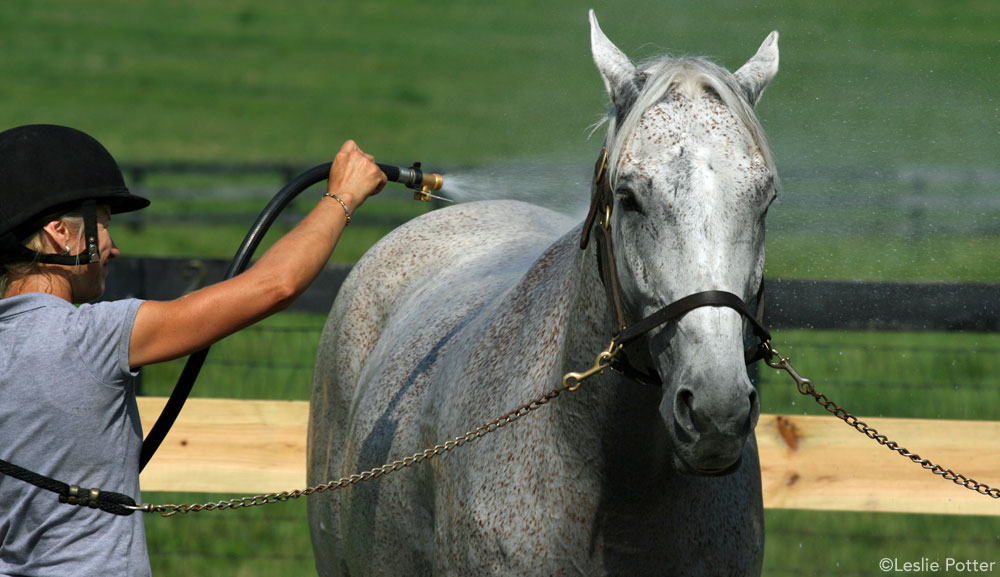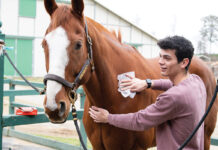Begin grooming sessions by currying, and then brush the coat, mane and tail. “Curry a horse in a circular motion from behind its ears all the way to its dock with a rubber curry,” says hunter and eventing trainer Denna Johnson of Full Partner’s Farm in Gainesville, Florida. “Go down the muscular and fatty parts of the leg, down to the knee and the hock, grooming firmly to make sure the horse gets a massage out of it.”

Bonnie Cicora, trainer and owner of the Post & Rail, an equestrian facility in Swanton, Ohio, says, “Finish up with the face using a very soft face brush. Always brush in the direction that the hair grows, being very careful around the eyes.”
When grooming, make sure that your brushes are clean, and avoid sharing them to prevent inadvertent transmission of superficial skin diseases.
Flowing Manes & Tails
“Handpicking a tail is ideal,” says Schils, “but…I spray the tail with a finishing spray, let it dry a little, then brush through very slowly, letting the spray help me through it. I lose very few tail hairs.” Using no-tangle preparations and care when grooming the tail, however, will help avoid pulling out hair.
For mane care, Johnson suggests taking a brush and brushing back and forth in the mane, making sure all the dirt comes up out of the scalp. Be sure to get all the way down to the base of the mane.
The Important Hoof
Each day, the hoof should be inspected for cracks and disease, then picked out. To pick a hoof, face the horse’s rear, stand next to the leg, and lean into the horse’s body to shift its weight off the side you’re going to work on. Run your hand down the leg, then lift up the foot with one hand, bending it at a natural angle. With a hoof pick, remove debris from the foot. Some prefer picking from the toe back toward the heel to avoid scratching the frog. Others prefer to work from the heel toward the toe to avoid pushing debris into the heel of the frog. After cleaning the bottom of the foot, clean the sides by brushing off dirt with a short, hard-bristle brush.
From End to End
As a daily practice, gently wipe the corners of the horse’s eyes with a clean washcloth to clear away the mucus or dirt that can collect. Be sure to wipe from the top outside edge of the eye down to the bottom inside corners, so as not to spread bacteria.
Don’t forget to clean under your horse’s dock. “Horses, as they defecate, will accumulate some debris underneath the dock of their tails,” says Schils. This debris can be irritating and cause tail rubbing. Use dampened disposable towelettes to wipe underneath the tail, the tail itself, the anal area, and in between and down the hind legs. Do not reuse these towelettes anywhere else on the horse’s body.
Bath Time
If you are careful, frequent bathing should not cause any extra problems for a healthy hoof. However, Henry Heymering, an AFA-certified journeyman farrier, warns not to let hooves stand in mud or water for any more than a few minutes, or trouble may follow.

Regardless of how often a horse is bathed, follow the basics. Wash the entire horse: face, mane, neck, body, legs, tail and underneath the tail. Scrub all the way down to the base of the mane and the tail. Always apply shampoo that has been diluted in water. Never let shampoo dry on the coat, and rinse off all traces of the soap.
Beauty From Within
Good grooming begins with good nutrition. “People bring a horse to me that is 75 pounds underweight, and then don’t understand why they can’t get a good shine on that horse’s coat or get the horse to shed out after winter,” says Johnson. “Check with your vet and make sure your worming, vaccinations and feeding programs are appropriate.”
Further Reading
30 Grooming Tips
Tips for Thicker Tails






Thanks for the grooming tips!!
Cool article… really made sense and helped.
very nice article 🙂
good article!
Great practical article!
Great article and extremely informative.
Timely article. Thanks
Very informative information..Thanks
a lot of people don’t think grooming is important this article proves otherwise
i’d like if this article told a little more about WHY grooming’s important and not just how. people don’t always realize that by using proper grooming techniques you can prevent disease, help circulation, and even just get an up-close look at your horse. Are there external parasites hiding in the hair or on/under the skin? do the hooves/teeth/eyes/ears look healthy?
This is really not helpful to me… but thanks anyway. I agree with previous comments, i want to know WHY grooming is important. This is more of a grooming 101. The title of the article implies that you were going to tell us why.
Helpful ideas.
This is the favorite part of my horse’s day. Getting a good brush and pedicure is like getting their favorite treat.
This was a great article…I like the little brushing tips for the tail & mane.
love that article <3
Good info